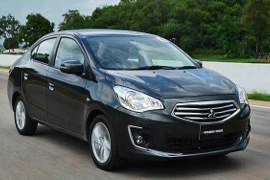MITSUBISHI Mirage G4 Models/Series Timeline, Specifications & Photos
First production year: 2013
Engines: Gasoline
Once a simple hatchback in the small-segment, the Mitsubishi Mirage evolved into a different vehicle over the years.
Mitsubishi faced some financial troubles, but it had to introduce new cars on the market. Its aged L200 Pickup and Outlander were, basically, the only vehicles that could sustain the brand on the market. The Lancer was already old, and so was the Pajero/Montero. It tried with the Space Star, which was mostly a rebadged Colt, but its success was limited. Then, in 2013, it introduced the four-door sedan Mirage based on the same platform as the Space Star. It was designed especially for the emerging markets, but it was also available on the North-American continent.
The carmaker tried to offer an aerodynamically efficient vehicle with the Space Star and obtained a 0.27 drag coefficient. When it transformed the vehicle into a four-door sedan, that advantage went down the drain, but it was still good for the car's size. But customers didn't see that. They saw a vehicle with a grille too high, two ascending lines on the sides, and a sloped rear end.
Inside, Mitsubishi installed a rounded dashboard with a piano-black center stack. They looked good in some pictures, but it was hard to hide the low-quality materials used. A big infotainment system with a touch-screen display was available on the upper trim levels. In the spirit of its glorious motorsport heritage, Mitsubishi installed an instrument cluster where it displayed only a tachometer and a speedometer. Despite having room for four adults inside, the short wheelbase led to limited legroom for the rear passengers.
The Mirage featured a 1.2-liter gasoline engine paired to a five-speed manual or to a CVT gearbox. There was no other option for it.
Mitsubishi tried its luck and introduced the four-door version of the Mirage in 2013 on the Canadian market, although a similar version was already present in a few Asian countries.
The Japanese automaker was not in good shape from a financial point of view. Thus, it tried to increase its presence in markets with low-budget vehicles, such as the Mirage. In addition, Mitsubishi tried to convince customers with an excellent warranty and enough features to make it attractive, especially for first-time car buyers and, why not, delivery companies.
Creating a sedan based on the same platform as a hatchback was common. Some automakers made that transition smoother, while others didn't. Mitsubishi was part of the second category. Unfortunately, the car's design was nothing worth writing home about it. Its front fascia revealed trapezoidal, swept-back headlights and a pointing-down trapezoidal chromed grille. From its profile, the sculptured ascending lines from the hatchback version were kept, although they faded on the rear quarter panels. At the back, the tall trunk and the sloped-down rear windscreen looked like they were added after the vehicle was already built. And yet, it was good enough for those who couldn't afford more expensive cars.
Inside, the Mirage G4, or Attrage as it was already known, featured hard-plastic areas on the door panels, dashboard, and center console. On the other hand, the bolstered bucket seats were comfortable enough even for long travels. Yet, the rear-seat passengers were not that happy with the legroom offered. But Mitsubishi offered the vehicle with enough features to make the Mirage attractive, such as keyless entry, power mirrors and front windows, alloy wheels, and a 60/40 split-folding rear bench.
Under the hood, there was only one engine option, a 76 hp (78 PS) inline-three powerplant mated to either a five-speed manual or a CVT.

